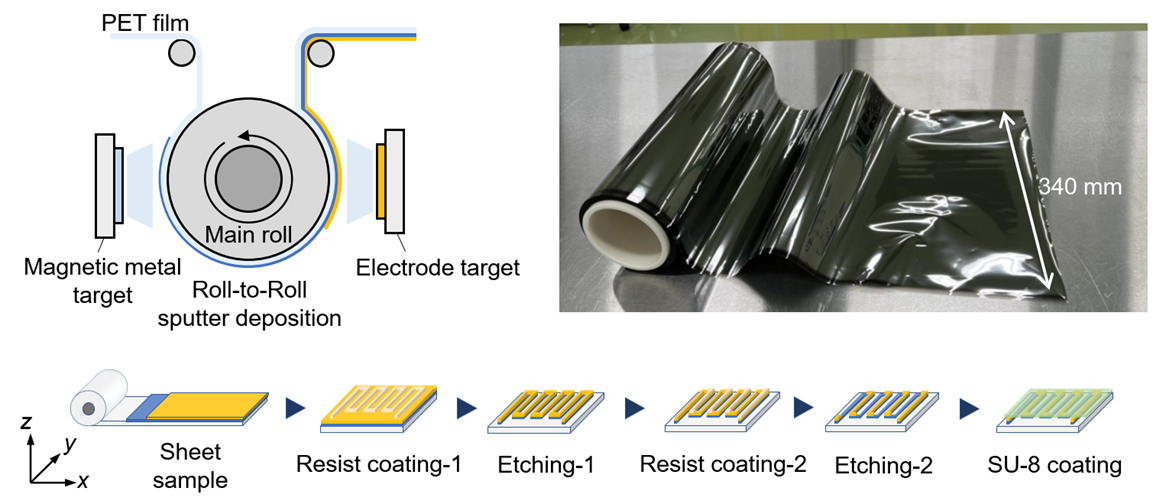A sign or cause of inefficient performance is surplus heat coming out from electronic or mechanical devices.

Making films. The roll-to-roll sputter deposition manufacturing technique is well established and can create etchable films in large quantities for use in commercial settings. Image Credit: ©2023 Tanaka et al. CC-BY-ND
In several cases, fixed sensors to track the flow of heat could assist engineers in changing device behavior or designs to enhance their efficiency. Initially, scientists exploit a novel thermoelectric phenomenon to construct a thin sensor that has the potential to envision heat flow in real time.
The sensor could be constructed deep inside devices where other types of sensors are known to be impractical. Also, it is rapid, simple, and affordable to manufacture with the help of well-established techniques.
As per the law of conservation of energy, energy is never created or destroyed but only changes form from one to another based on the interaction happening between the entities involved. Ultimately, all energy ends up as heat.
For humans, it could be beneficial, for instance, when one wants to heat the home in winter, or harmful when one wants to cool something down or get the most out of a battery-driven application.
In any case, the better one could control the thermal behavior of a device, the better one could engineer this unavoidable effect and enhance the efficiency of the device in question. But this is easier said than done, as identifying how heat flows within some complicated, miniature, or dangerous device is something varying from the hard to the impossible, based on the application.
Having been inspired by this issue, Project Associate Professor Tomoya Higo and Professor Satoru Nakatsuji from the Department of Physics at the University of Tokyo, and their team, which consisted of a corporate collaboration, set forth to find a solution.
The amount of heat conducted through a material is known as its heat flux. Finding new ways to measure this could not only help improve device efficiency, but also safety, as batteries with poor thermal management can be unsafe, and even health, as various health or lifestyle issues can relate to body heat.
Tomoya Higo, Project Associate Professor, The University of Tokyo
Higo added, “But finding a sensor technology to measure heat flux, while also satisfying a number of other conditions, such as robustness, cost efficiency, ease of manufacture, and so on, is not easy. Typical thermal diode devices are relatively large and only give a value for temperature in a specific area, rather than an image, of the heat flux across an entire surface.”
The research group examined the way a heat flux sensor comprising some unique magnetic materials and electrodes acts when there are complex patterns of heat flow. The magnetic material based on gallium and iron displays a phenomenon called the anomalous Nernst effect (ANE), which is where heat energy is remarkably converted to an electrical signal.
This is not the only magnetic effect that could turn heat into power. Also, there is the Seebeck effect, which has the potential to make more electrical power. However, it needs a huge bulk of material, and the materials are brittle and hard to work with. At the same time, ANE enabled the team to fabricate their device on a malleable sheet and incredibly thin plastic.
By finding the right magnetic and electrode materials and then applying them in a special repeating pattern, we created microscopic electronic circuits that are flexible, robust, cheap, and easy to produce, and most of all are very good at outputting heat flux data in real-time.
Tomoya Higo, Project Associate Professor, The University of Tokyo
Higo added, “Our method involves rolling a thin sheet of clear, strong, and lightweight PET plastic as a base layer, with magnetic and electrode materials sputtered onto it in thin and consistent layers. We then etch our desired patterns into the resultant film, similar to how electronic circuits are made.”
The circuits were designed by the research group in a specific kind of way to improve ANE whilst also inhibiting the Seebeck effect, as this interferes with the data-gathering potential of ANE. Earlier attempts made to do this were unsuccessful in any method that could be scaled up easily and possibly commercialized, thereby making this sensor the first of its kind.
I envisage seeing downstream applications such as power generation or data centers, where heat impedes efficiency. But as the world becomes more automated, we might see these kinds of sensors in automated manufacturing environments where they could improve our ability to predict machine failures, certain safety issues, and more.
Satoru Nakatsuji, Professor, Department of Physics, University of Tokyo
Nakatsuji added, “With further developments, we might even see internal medical applications to help doctors produce internal heat maps of specific areas of the body, or organs, to aid in imaging and diagnosis.”
Journal Reference
Tanaka, H., et al. (2023) Roll-to-Roll Printing of Anomalous Nernst Thermopile for Direct Sensing of Perpendicular Heat Flux. Advanced Materials. doi.org/10.1002/adma.202303416.